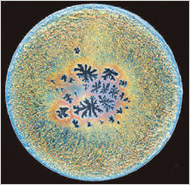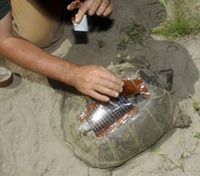Category: Science
Twentyfour:London bar and nightclub is the most technologically-advanced yet

The launch of a new bar in London has got the whole of Shiny Towers in a tizz, not just because it’s literally down the road from our offices and we’re renowned cocktail-supping gals, but because it promises to be not just London’s most technologically-advanced bar, but possibly the world’s too.
It’s reportedly the first bar in the world with a fully-interactive interior, where customers can control projected images on every wall, choosing between ‘dot matrix sci-fi chic, crashing sea surroundings, Californian desert scenery’, or even your own images and videos. If you fancy getting even more involved with the interior decoration, you can play with the interactive virtual Koi Carp, or dance and watch your thermal shadows on the walls replicating every shape being thrown…
Panasonic eyes up new walkthrough iris-recognition gate
 One of the best technology launches I’ve ever attended was for some new iris-recognition based ID systems for airports. Why? It’s the only press conference where serious security journalists were asking questions like ‘Could it detect severed eyeballs?’ and ‘Can it tell a live person’s eyes from a dead person’s?’. I wanted their jobs.
One of the best technology launches I’ve ever attended was for some new iris-recognition based ID systems for airports. Why? It’s the only press conference where serious security journalists were asking questions like ‘Could it detect severed eyeballs?’ and ‘Can it tell a live person’s eyes from a dead person’s?’. I wanted their jobs.
Study suggests educational DVDs and TV may not be so good for baby after all
 A new study from researchers at the University of Washington suggests that using educational TV and DVD, such as the “Baby Einstein” and “Brainy Baby” series, or “Sesame Street”, may not be as beneficial for babies and young children as many hoped.
A new study from researchers at the University of Washington suggests that using educational TV and DVD, such as the “Baby Einstein” and “Brainy Baby” series, or “Sesame Street”, may not be as beneficial for babies and young children as many hoped.
It’s hardly a crime for parents to let their children watch some TV, and if it’s teaching them something too, so much the better (at least, better than letting them watch Big Brother). Even so, the study suggests that for every hour per day that babies watch these DVDs and videos, they learn six to eight fewer new vocabulary words than babies who hadn’t watched them.
Now, parents being told what’s best for their kids by University boffins often leads to emotions running high. While these studies suggest that children who sit passively in front of TV shows don’t do as well educationally, child-raising is a helluva lot more complicated than that.
Now mobile phones are being used for… appendix surgery?

No, Motorola hasn’t kitted its next RAZR out with a special intestine-slicing add-on. Although it’s a thought. Instead, surgeons in Argentina were forced to use mobile screens to illuminate an emergency appendectomy, after a power blackout nixed the lights in their operating theatre.
easyJet go green
They may be known for their garish orange but Stelios seems to fancy a colour change – his budget airline has unveiled a new fuel efficient plane, The Ecojet.
It’s not just a normal flyer with better fuel efficiency, this has two open rotor jet engines at the back of the airplane, which, according to the firm, improve the overall performance of the plane. The wings are swept forward to reduce drag and the body is made with lightweight carbon fibre to reduce the overall weight…
MIT builds Digital Water Pavilion out of… water

“To understand the concept of digital water, imagine something like an inkjet printer on a large scale, which controls droplets of falling water,” said Carlo Ratti, head of the MIT’s Senseable City Laboratory. This is the principle behind the Digital Water Pavilion, a structure designed for Expo 2008 in Zaragoza, Spain. Thousands of water jets will be programmed to show images or text, but made of simply a thin film of water which can be easily walked through. “The entire surface becomes a one-bit-deep digital display that continuously scrolls downward.” Hard to picture? Check out the video at DigitalWaterPavilion.com. [GT]
Related posts
Gigantic nuclear explosion video
Using noise to increase laser signal
TurtleNet: Turtles test wireless network
Gigantic nuclear explosion video
The Discovery Channel ran footage of the largest nuclear explosion ever captured on film. This bang is so enormous, the plume reaches above the cloud cover, and the fallout radius is a quick 180km. It was detonated by the Russians as part of nuclear testing, and now the footage is online for you to reflect on. Video after the jump. [GT]
Worlds Largest Nuke Explosion (via Futurismic)
Related posts
UK’s First Nuclear-Powered Website, From Geiger Counters To Toxic Waste T-Shirts
Nuclear Website Trawled by Spooks
Run your Own Nuclear Power Plant
Using noise to increase laser signal

While noise is usually a bad thing for your signal (hence the ‘signal to noise ratio’ concept) a group of researchers from Belgium, France and Spain have found that adding a tiny dose of noise to a an electrical current can make a smoothly controlled laser where before they had an uncontrolled one. The vertical-cavity surface-emitting lasers (VCSELs) would be extremely useful in boosting bandwidth if they were reliable (unlike now). They’re not sure why it works – noise ought to generally be a negative deal – but there’s another truism: whatever works, works. [GT]
Related posts
Multi Meter with spirit level and laser
Shiny Video Review: Microsoft Wireless Laser Desktop Keyboard and Mouse
SeeReal Hologram Television: buy this TV and dinosaurs will eat you
TurtleNet: Turtles test wireless network
Snapping turtles in Massachusetts are being used to test a new form of wireless network. They’re being fitted with tiny waterproof computers which will record the turtle’s movements and body temperature. The information is then conveyed to a base station which transmits the data to the University of Massachusetts. The idea behind the technology, known as TurtleNet, is to create a network of constantly moving devices that record and store information, transmit data from one device to another, then relay all the saved information to a central location while running on self-charging batteries. The information about the turtles will allow biologists to have a better understanding about turtle habitats which can help protect the species. Computer science and biology: two disciplines helping each other. (Don’t worry about the turtles: the machine is small enough to not interfere with their doings “or mating”.) [GT]
Related post:
“Don’t call me artist,” says sci-photog Frankel
"Don't call me artist," says sci-photog Frankel

“When it’s art, it’s more about the creator, not necessarily the concept in the image,” said Felice Frankel, senior research fellow at the Institute for Innovative Computing at Harvard. Frankel photographs science at the molecular level, to allow researchers clear and vivid images of the substances they work with. “To me the idea is to engage somebody to look at something, and they don’t even know it’s science,” she said. Her first collaborator, Dr. Whitesides of Harvard, says, “her impact on scientific communication has been very large, in the way science talks to science and science talks to the world outside science.” [GT]
Felice Frankel (via NY Times)
Related posts
The BEST architectural art installation you will ever see
Bio-art interfaces life and art
Hybrid Motorcycles: a three-pack from eCycle, Inc. and Machineart


















